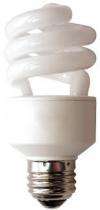Mandated change in light bulbs to occur at year's end

Get ready for some mandated changes in lighting, warns an energy expert in Penn State's College of Agricultural Sciences.
Effective Jan. 1, 2012, it will be a federal offense for any company, organization or individual in the United States to manufacture or import 100-watt incandescent light bulbs for general-use lighting. Dennis Buffington, professor of agricultural engineering, said California already has banned the 100-watt incandescent bulbs starting this year. The reason for the ban is the availability of other lighting alternatives today that are considerably more energy-efficient than the incandescent bulbs.
"You can continue using your 100-watt incandescent bulbs next year, and you can replace those bulbs with other 100-watt incandescents that you may have in inventory," Buffington said. "But you will be unable to purchase the bulbs after Jan. 1, 2012. In fact, you may not be able to find them in stores during the last few months of 2011."
Smaller sizes of incandescent bulbs for general use will be banned at later dates. Effective Jan. 1, 2013, 75-watt incandescent bulbs will face a similar ban; the 60-watt and 40-watt incandescents will be banned effective Jan.1, 2014.
"Specialty incandescent bulbs will not be subject to these bans," Buffington said. "Specialty bulbs include three-way bulbs, appliance lights, 'bug lights,' colored bulbs, vibration-service and rough-service bulbs, and bulbs used for marine and mining applications."
When searching for an alternative to incandescent bulbs, Buffington advised, evaluate the lights on the basis of lighting efficiency, expressed as lumens per watt. The wattage rating of a bulb merely indicates the wattage of electricity required for input to the bulb. The light output is measured in lumens. Thus, lighting efficiency is expressed as lumens per watt.
"The compact fluorescent lamp (CFL) produces about four times the amount of light that an incandescent bulb produces on a per-watt basis," Buffington explained. "An additional benefit is that the CFL has a life span of about 10,000 hours versus 1,000 hours for a typical incandescent. A disadvantage of the CFL is that the bulb contains both mercury and lead -- potentially hazardous heavy metals."
Although CFL bulbs contain significantly less mercury and lead than they did a decade ago, the bulbs still must be handled in a responsible manner for disposal, Buffington cautioned. Most "big box" home improvement stores now have drop-off sites for proper disposal of the burned-out CFL bulbs, he pointed out.
CFLs now are available in many different sizes, shapes and colors of light (soft white, cool white, warm glow, etc.). The typical CFL sold today is a coiled tube, although some are available with an outer glass shell that hides the coil. The bulbs with the covered coils look like incandescents but with the efficiency and long life of CFLs.
"CFLs that can be used with dimmer switches now are available," Buffington said. "Be careful though. Only the CFLs that are labeled as dimmable on the packaging will function properly when used with a dimmer switch.
"LED (light-emitting diode) bulbs are even more efficient than the CFL, and the life of an LED is longer than the CFL," he said. "LEDs are free of both mercury and lead. But I do not recommend LEDs today simply because they still are too expensive, although the prices have dropped in recent years. I anticipate significant reductions in the price of LEDs within the next five years or so, and then they may be feasible lighting alternatives."
Provided by Pennsylvania State University


















